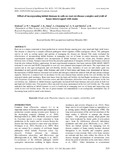Effect of incorporating lablab biomass in soils on root rot disease complex and yield of beans intercropped with maize

View/
Date
2014Author
Muthomi, J W
Mugambi, I K
Ojiem, J
Chemining’wa, G N
Nderitu, J H
Language
enMetadata
Show full item recordAbstract
Root rot is a major constraint to bean production in western Kenya causing poor crop stand and high yield losses.
The disease is caused by a complex different pathogens which together exhibit synergistic effects. The pathogens
survive in soils as resting s
pores and options of managing the disease are limited This study evaluated the
effectiveness of incorporating lablab biomass in managing root rot of beans in maize intercrop system. The
experimental treatments evaluated were incorporation of lablab biomass
over the whole plot, biomass placed
between rows of beans, biomass removed from the plot plus application of inorganic fertilizer and biomass removed
from the plot without fertilizer application. In each experimental treatment, four bean varieties KK8, KK
15, KK072
(tolerant to root rot) and GLP2 (susceptible to root rot) were planted intercropped with maize. The experiment was
carried out at two agro
-
ecologically and soil fertility diverse sites. Incidence of root rot and chafer grub was
determined at earl
y growth stages while biomass and yield of both maize and beans were determined at harvest.
Incorporation of lablab biomass increased soil carbon and nitrogen content but reduced both pH and cation exchange
capacity. However, it reduced root rot incidence
for the root tolerant bean varieties at the low soil fertility site but
increased chafer grub incidence. Bean stem bases from the high soil fertility site had higher incidences of infection
with
Fusarium oxysporum
while
Fusarium solani
and
Macrophomina ph
aseolina
were more prevalent in the low
soil fertility site. Addition of lablab biomass significantly increased both bean biomass and seed yields in both low
and high soil fertility sites. The positive effect on yield was more pronounced at the low soil fe
rtility site. The study
indicated that addition of lablab biomass to soils is beneficial in managing root rot of beans and improving crop
yields in low soil fertility areas. The use of green manure soil amendments is an ecologically sustainable way of
incr
easing bean yield for small scale farmers.
Publisher
University of Nairobi
